Butterflies of the Adirondacks:
Monarch (Danaus plexippus)
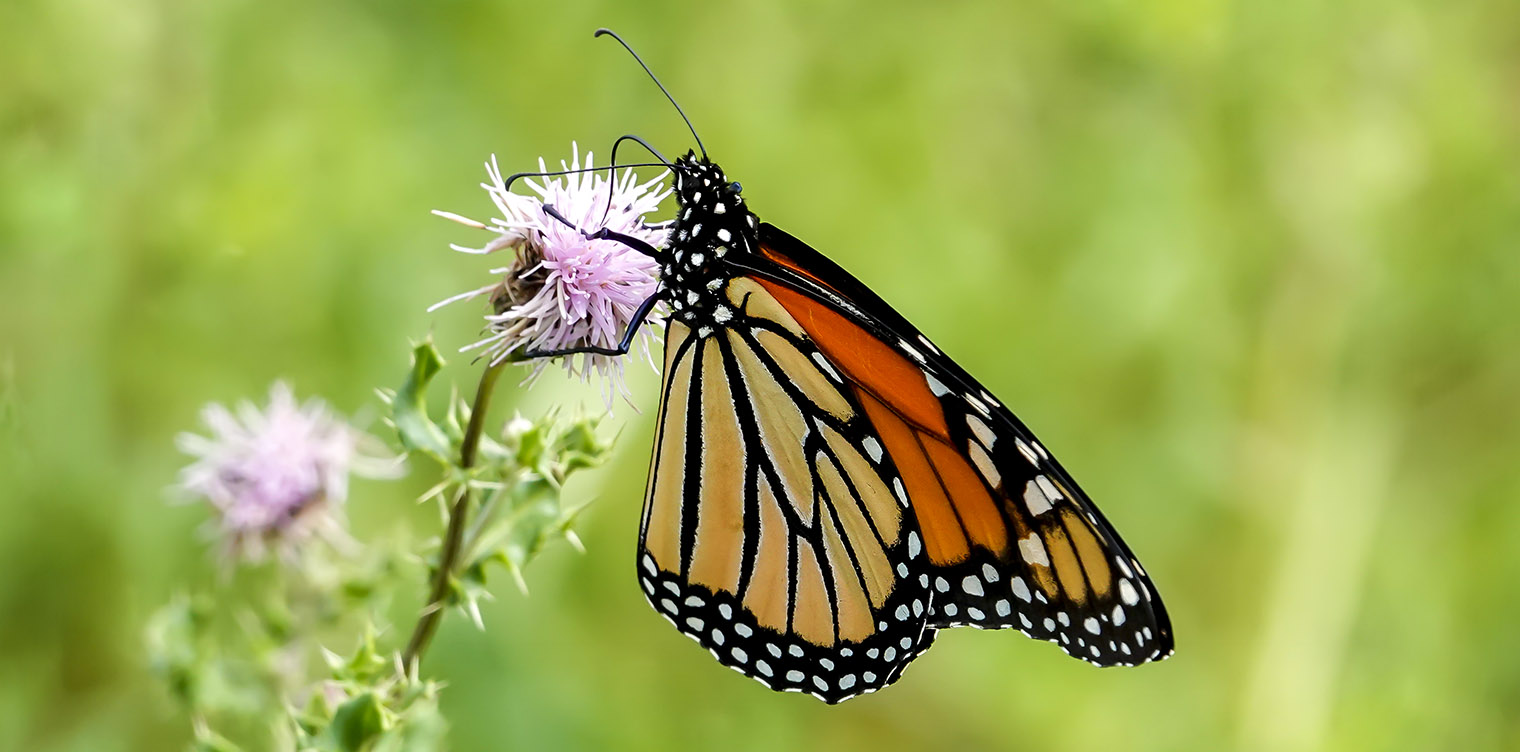
Monarchs (Danaus plexippus) are large orange and black butterflies that may be seen in the Adirondack Mountains of upstate New York throughout the summer months. The Monarch is a member of the Brushfoot family. [1] It is probably the best-known butterfly in North America. [2] The genus name is said to be derived from Danaus, a character in Greek mythology. [3]
The Monarch is also known as the Milkweed Butterfly [4] – a reference to the insect's favored food. The milkweed consumed by both caterpillars and adult Monarchs has some protective value. All milkweeds contain cardiac glycosides, which are poisonous. These substances are stored in the bodies of both the caterpillar and the adult butterfly and are distasteful to predators. [5] Birds that attempt to eat adult Monarchs or caterpillars vomit and associate this experience with the appearance of the insect, learning to avoid them in the future. [6]
Monarch: Identification
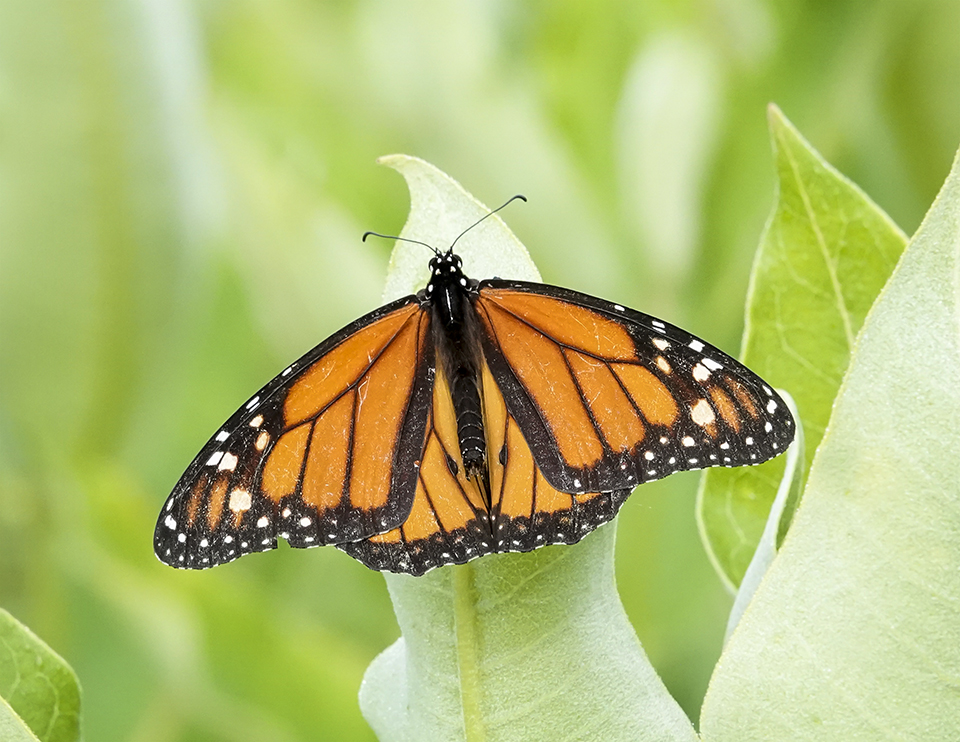
The upper side of the male Monarch is bright orange with a black border, as well as heavy black veins. The hind wing of the male has a small patch of scent scales – a wider area of black scales on a vein just below the center of the hind wing. [7] [8] [9] This can be seen easily when the Monarch has its wings open. [10] The female Monarch is orange-brown with black borders and blurred black veins. [11] Both males and females have a double row of white spots within the black border on the wings. [12] There are three orange patches on the tip of the fore wing. [10]
The underside of the Monarch is similar to the upper side, but the hind wing is much paler orange. [13] The Monarch's wing span is 3.5 to 4 inches. The hind wings are much more rounded than the fore wings. [14] Adult Monarchs can often be seen basking with their wings open and toward the sun.
In appearance, the Monarch is similar to the Viceroy, but lacks the Viceroy's distinctive black line across the hind wing. In addition, the Viceroy has a single row of white spots within the black border, in contrast to the Monarch, which has a double row. [15] [16]
Monarch: Life History
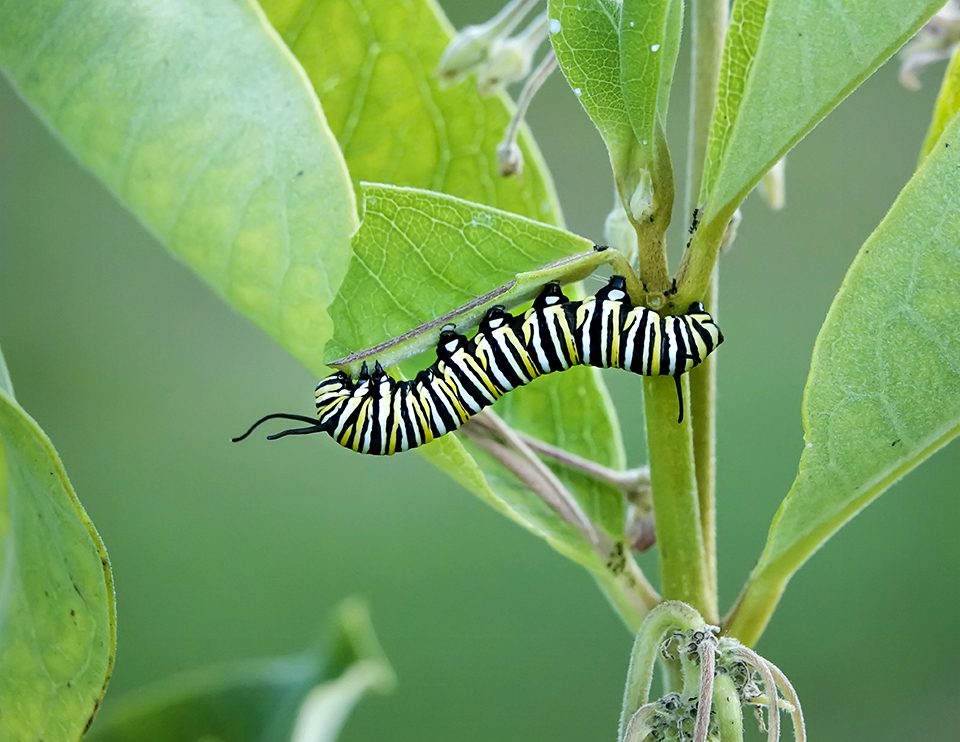
The four stages of the Monarch's life cycle are the egg, the larva (caterpillar), the pupa (chrysalis), and the adult butterfly. [17] The process of growth and change is called metamorphosis and is triggered by hormones circulating within the body. [18] The process of Monarch development from egg to adult is completed in about thirty days. [19] If you visit the Paul Smiths VIC Butterfly House, you can observe this life cycle in a glassed-in cabinet where Monarchs are reared.
Female Monarchs lay eggs singly under host leaves, usually common milkweed, swamp milkweed, or showy milkweed, secreting a small amount of glue to attach the eggs directly to the plant. [20] Sources differ on the number of eggs laid by female Monarchs, with some sources indicating that the butterflies lay an average of about 700 eggs,[21] while others state that the average female Monarch appears to lay about 300 to 400 eggs in her lifetime. [22] Captive Monarchs lay many more. The eggs are pale green and ribbed.[23] Monarch eggs take about four to six days to hatch, depending on temperature. [24] [25]
The caterpillar or larva which emerges from the egg is banded in white, black, and yellow. [26] The head capsule is white and black striped. [27] The caterpillar's major occupation is eating. [28] They first eat their eggshell and then begin consuming the milkweed leaves on which they were laid. [29] Newly-born caterpillars are very small and expand as they start growing. Because the exoskeleton does not stretch, the caterpillar grows by molting (shedding its skin). [30] The stages between larval molts are called instars. Monarchs go through five separate larval instars, increasing their body mass about 2000 times. [31] The larval stage lasts about nine to fourteen days, again depending on temperature. [32] [33]
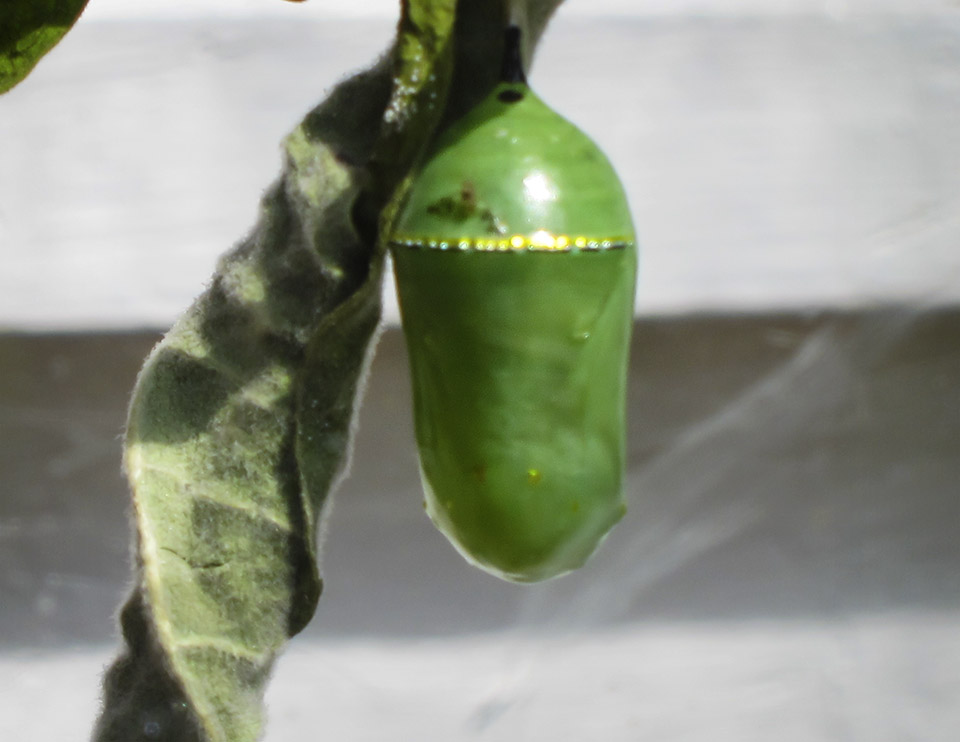
During the next stage – the pupal stage – the transformation from larva to adult is completed. [34] At this time, the fully-grown larva spins a silk mat, attaching itself to a stem or a leaf as part of its transformation into a chrysalis or pupa. The chrysalis is about 7/8 inch long and is jade green, studded with gold. [35] [36] The chrysalis starts out light green in color, gradually darkening throughout the process. [37] Just before the butterfly emerges, their black and orange wing patterns become visible through the pupa covering. [38] The pupal stage takes about nine to fifteen days to complete. [39]
The adult Monarch emerges when the process of transformation is complete. When the butterfly first emerges from the chrysalis, both of its wings are soft and folded against its body. The butterfly then rests for a while and pumps blood into its wings. Within a three or four-hour period, the butterfly is usually ready to fly and search for a mate.
Adult Monarchs consume the nectar from milkweeds, but they also visit a variety of other flowers. Adult Monarchs live two to six weeks in the summer, while those that migrate south may life throughout the winter (about six to nine months). [40]
Monarch: Migration
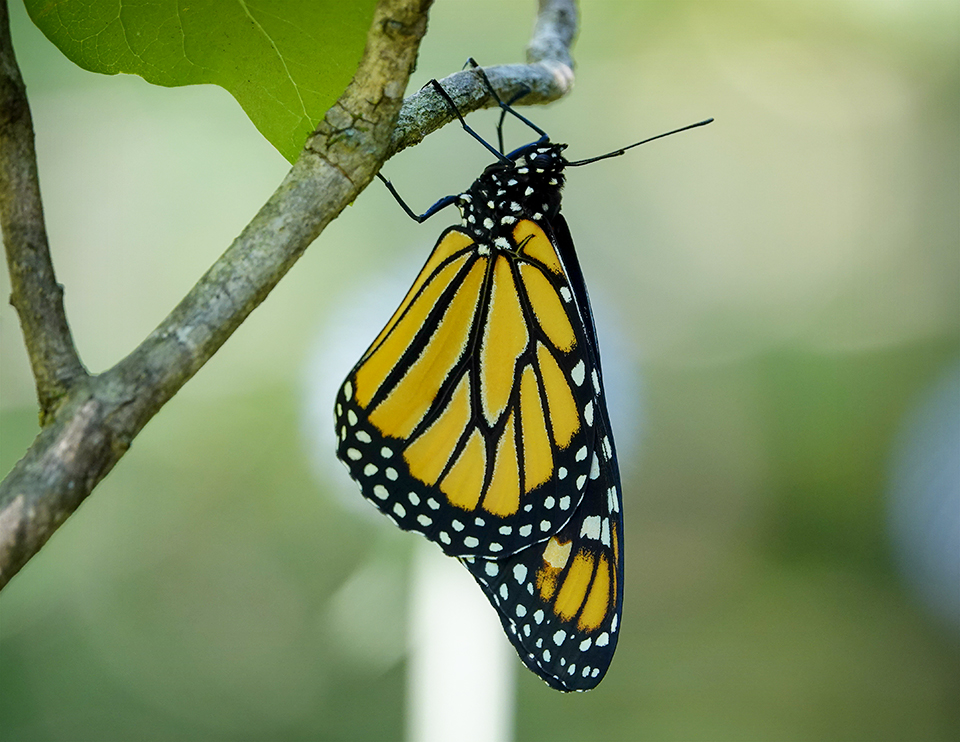
The Monarch is probably the best known of all migratory butterflies, migrating from overwintering sites in the south to its northern home in the spring and back again in the fall. [41] The Monarch is the only butterfly which makes such a lengthy two-way migration. [42]
The Monarch's migratory behavior depends on region. West Coast Monarchs migrate in fall from northern regions to southern California. [43]
By contrast, most Monarchs seen during the summer in the Adirondack Mountains and in the rest of eastern and central North America are part of a migratory process that ends in Mexico. However, no single individual makes the round-trip journey. [44] [45] The migration process involves several Monarch generations.
Monarchs migrate from our area in late summer (usually September). Spring and summer Monarchs become reproductive a few days after they emerge from the chrysalis. However, those Monarchs which emerge in late summer and early fall are in a state of suspended reproductive development called diapause, which is triggered by environmental factors such as decreasing day length and fluctuating temperatures.[46] These Monarchs become part of the fall migration southward.
Monarchs travel at a rate of about fifty miles per day, usually following river valleys or the sea coast. Scientists do not know precisely how the butterflies orient themselves during migration. Possibilities include the angle of the sun, as well as polarized light patterns to orient on cloudy days. [47]
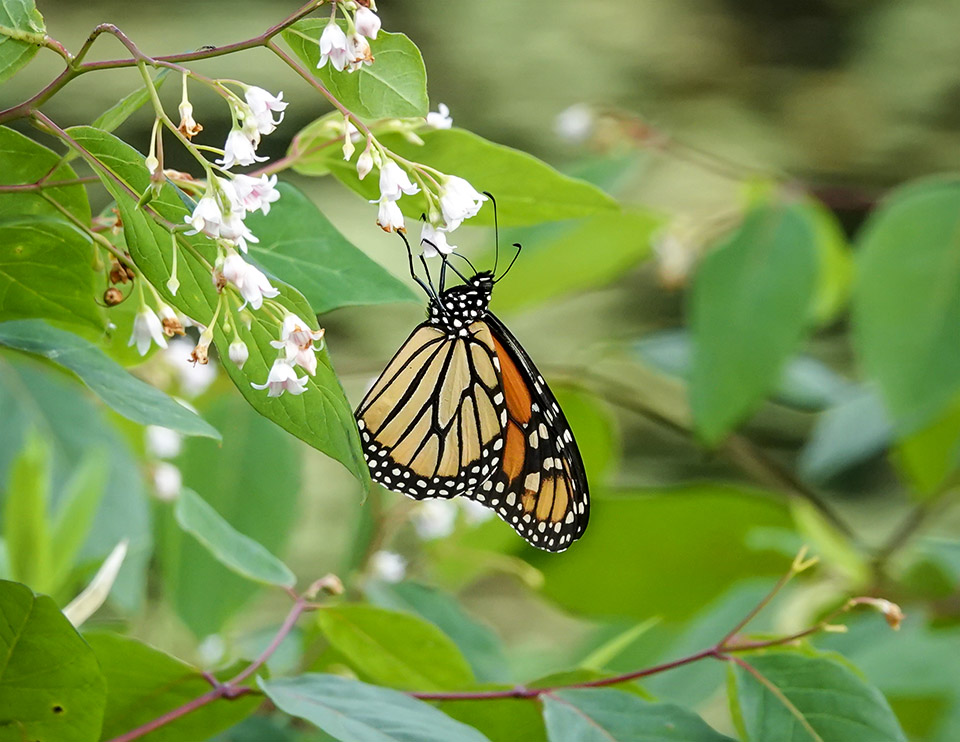
During migration, Monarchs pause to take nectar from fall-blooming flowers and often roost at night, sometimes by the thousands. [48] Although some Monarchs from eastern North America winter in the southern states or in the Caribbean, most head toward overwintering sites in the highlands of central Mexico, [49] where they spend the winter in a few small groves of evergreen trees. [50] These wintering Monarchs roost in trees in groups that may number in the millions. [51]
The warm days of March triggers the Monarchs' northward flight. The Monarchs fan out across the southern US; and the females deposit their eggs on milkweed plants. When these eggs hatch, the emergent caterpillars feed on the milkweed leaves, then (ten to fifteen days later) forms a chrysalis. In another ten to fifteen days, a new Monarch emerges to continue the northward journey. This process repeats itself, with each new generation of butterflies mating, laying eggs, and dying within the span of a few weeks.[52] In this way, the Monarchs born in our area of the Adirondack Park are the descendants of those butterflies who left the southern overwintering areas in the early spring.[53]
Monarch: Habitat and Range
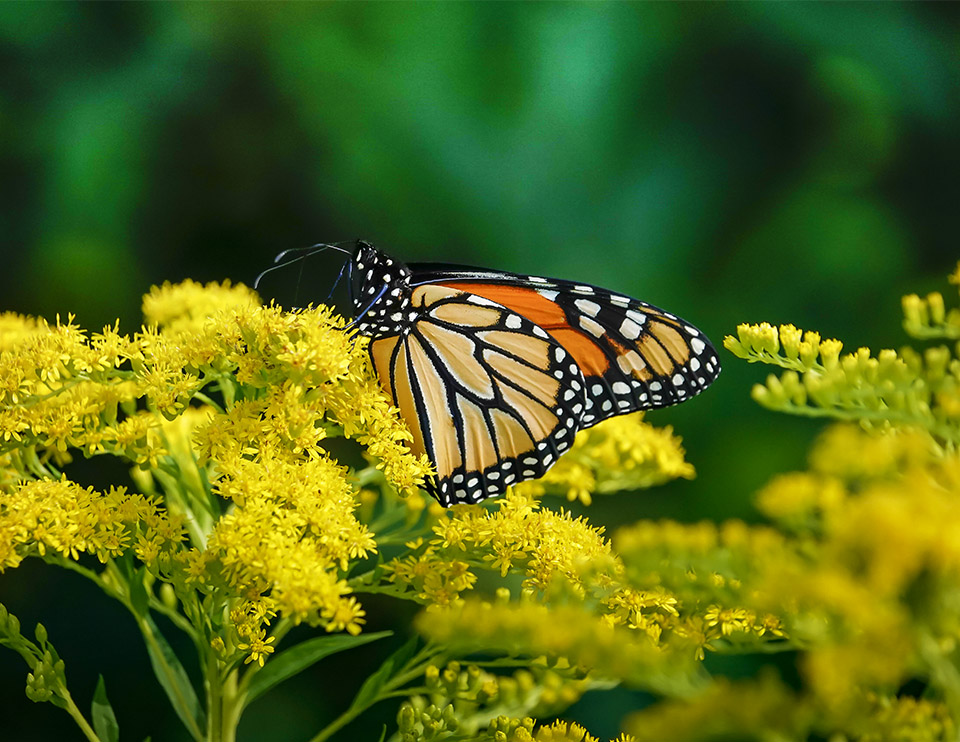
Monarchs thrive in many open habitats, including fields, meadows, weedy areas, marshes, and roadsides. [54] They can also be found in cities, suburbs, and towns, as well as grasslands and prairies. [55]
The abundance of Monarchs varies from year to year, depending on weather conditions and survival rates over the winter. [56] [57] [58]
The Monarch's range is quite large. It can be seen in much of temperate North America into Central America and much of South America. [59] It is also present in some islands in the Pacific, as well as Australia. [60]
Monarch: Flight
The flight period for Monarchs in New York State (the New York City area) is from mid-May to mid-October; they are most abundant in that region from the beginning of July to the end of September. [61]
In the Adirondacks, Monarchs usually arrive in June, although some may arrive towards the end of May. In most years, most adult Monarchs appear to depart in early September.
- In 2012, which was a very good year for Monarchs, adult Monarchs were present in the Paul Smiths VIC Native Species Butterfly House from early June to early September. [62]
- In 2013, adult Monarchs were present in late June and early July, then again in late July and early August. [63]
- In 2014, Monarchs sightings were reported in the Adirondack Park from early July to early August. [64]
- In 2015, there were confirmed Monarch sightings in the Adirondack region in late July, early August, and late August. [65]
- In 2016, there were confirmed Monarch sightings in the Adirondack Park in July, late August, and early September. [66]
- In 2017, there were confirmed Monarch sightings in the Adirondack Park in late June, mid- to late July, mid- to late August, September, and early October. [67]
- In 2018, there were confirmed Monarch sightings in the Adirondack Park in July, mid- to late August, September, and early October. [68]
- In 2019, there were confirmed Monarch sightings in the Adirondack Park from late June through early October. [69]
- In 2020, there were confirmed Monarch sightings in the Adirondack Park from late June through mid-October. [70]
- In 2021, there were confirmed Monarch sightings in the Adirondack Park from late June through mid-October, with one sighting in early June. [71]
References
- Susan Grimm Hanley. Interpretive Naturalist, Paul Smith's College Native Species Butterfly House. Species Logbooks.
- Butterflies and Moths of North America. Species Profiles. Sighting records: 6/16/2012; 6/30/2012; 7/10/2012; 7/18/2012; 7/30/2012; 8/4/2012; 8/8/2012; 8/20/2012; 8/20/2012; 8/25/2012; 9/1/2012; 9/1/2012, 7/27/2013, 7/31/2013, 8/21/2013, 8/21/2013; 7/5/2014; 7/12/2014; 7/12/2014; 7/12/2014; 7/12/2014; 7/19/2014; 7/19/2014; 7/19/2014; 7/19/2014; 7/19/2014; 7/26/2014; 8/1/2014; 8/1/2014; 8/1/2014; 8/2/2014; 8/8/2014; 8/8/2014; 8/11/2014; 8/8/2014; 7/29/2015; 8/6/2015; 8/23/2015.
- Butterflies and Moths of North America. Family Nymphalidae (Brush-footed Butterflies). Retrieved 21 August 2019.
- iNaturalist. Adirondack Park Sightings 2016. Monarch. Retrieved 21 August 2019.
- iNaturalist. Adirondack Park Sightings 2017. Monarch. Retrieved 21 August 2019.
- iNaturalist. Adirondack Park Sightings 2018. Monarch. Retrieved 21 August 2019.
- iNaturalist. Adirondack Park Sightings 2019. Monarch. Retrieved 19 June 2021.
- iNaturalist. Adirondack Park Sightings 2020. Monarch. Retrieved 13 June 2022.
- iNaturalist. Adirondack Park Sightings 2021. Monarch. Retrieved 13 June 2022.
- University of Minnesota. MonarchLab. Monarch Life Cycle.
- University of Minnesota. MonarchLab. Annual Life Cycle.
- MonarchWatch. Monarch Life Cycle.
- Government of Canada. Canadian Biodiversity Information Facility. SpeciesBank.
- Massachusetts Butterfly Club. Massachusetts Butterfly Species List.
- Monarch Joint Venture. Overwintering. Retrieved 21 August 2019.
- Monarch Joint Venture. Types of Monarch Habitat. Retrieved 21 August 2019.
- Iowa State University. Department of Entomology. BugGuide.
- University of Michigan. Animal Diversity Web.
- Ross A. Layberry, Peter W. Hall, and J. Donald Lafontaine. The Butterflies of Canada (University of Toronto Press, 1998), pp. 213-214, Plates 20 & 21.
- Karen S. Oberhauser. "Overview of Monarch Breeding Biology," Karen S. Oberhauser and Michelle J. Solensky, eds. The Monarch Butterfly: Biology and Conservation (Cornell University Press, 2004), pp. 3-7.
- Michelle J. Solensky. "Overview of Monarch Migration," Karen S. Oberhauser and Michelle J. Solensky, eds. The Monarch Butterfly: Biology and Conservation (Cornell University Press, 2004), pp. 79-83.
- National Audubon Society. Field Guide to Butterflies (New York: Alfred A. Knopf, 1981), pp. 711-713.
- Jim P. Brock and Kenn Kaufman. Kaufman Field Guide to Butterflies of North America (Houghton Mifflin, 2003), pp. 226-227.
- Paul A. Opler. A Field Guide to Eastern Butterflies (The Peterson Field Guide Series, Houghton Mifflin Company, 1992,1998), pp. 48-49, 50-51, 96-97, 313-314.
- Jeffrey Glassberg. Butterflies of North America (Michael Friedman Publishing, 2002), pp. 174-175.
- James A. Scott. The Butterflies of North America. A Natural History and Field Guide (Stanford University Press, 1986), pp. 229-231.
- Donald and Lillian Stokes. Stokes Butterfly Book. The Complete Guide to Butterfly Gardening, Identification, and Behavior (Little, Brown and Company, 1991), pp. 88-91.
- Jeffrey Glassberg. Butterflies through Binoculars. The East. A Field Guide to the Butterflies of Eastern North America (Oxford University Press, 1999), p. 143-144, Plate 45.
- Paul A. Opler and George O. Krizek. Butterflies East of the Great Plains: An Illustrated Natural History (The Johns Hopkins University Press, 1984), pp. 193-195, Plate 37.
- Rick Cech and Guy Tudor. Butterflies of the East Coast. An Observer's Guide (Princeton University Press, 2005), p. 191.
- David Carter. Butterflies and Moths (Dorling Kindersley, Inc., 1992), p. 184.
